Related Research Articles

Eridu was a Sumerian city located at Tell Abu Shahrain, also Abu Shahrein or Tell Abu Shahrayn, an archaeological site in Lower Mesopotamia. It is located in Dhi Qar Governorate, Iraq, near the modern city of Basra. Eridu is traditionally considered the earliest city in southern Mesopotamia based on the Sumerian King List. Located 24 kilometers south-southwest of the ancient site of Ur, Eridu was the southernmost of a conglomeration of Sumerian cities that grew around temples, almost in sight of one another. The city gods of Eridu were Enki and his consort Damkina. Enki, later known as Ea, was considered to have founded the city. His temple was called E-Abzu, as Enki was believed to live in Abzu, an aquifer from which all life was thought to stem. According to Sumerian temple hymns, another name for the temple of Ea/Enki was called Esira (Esirra).
"... The temple is constructed with gold and lapis lazuli, Its foundation on the nether-sea (apsu) is filled in. By the river of Sippar (Euphrates) it stands. O Apsu pure place of propriety, Esira, may thy king stand within thee. ..."

The Sumerian King List or Chronicle of the One Monarchy is an ancient literary composition written in Sumerian that was likely created and redacted to legitimize the claims to power of various city-states and kingdoms in southern Mesopotamia during the late third and early second millennium BC. It does so by repetitively listing Sumerian cities, the kings that ruled there, and the lengths of their reigns. Especially in the early part of the list, these reigns often span thousands of years. In the oldest known version, dated to the Ur III period but probably based on Akkadian source material, the SKL reflected a more linear transition of power from Kish, the first city to receive kingship, to Akkad. In later versions from the Old Babylonian period, the list consisted of a large number of cities between which kingship was transferred, reflecting a more cyclical view of how kingship came to a city, only to be inevitably replaced by the next. In its best-known and best-preserved version, as recorded on the Weld-Blundell Prism, the SKL begins with a number of fictional antediluvian kings, who ruled before a flood swept over the land, after which kingship went to Kish. It ends with a dynasty from Isin, which is well-known from other contemporary sources.
Uruk, known today as Warka, was an ancient city in the Near East, located east of the current bed of the Euphrates River, on an ancient, now-dried channel of the river. The site lies 93 kilometers northwest of ancient Ur, 108 kilometers southeast of ancient Nippur, and 24 kilometers southeast of ancient Larsa. It is 30 km (19 mi) east of modern Samawah, Al-Muthannā, Iraq.

Cuneiform is a logo-syllabic writing system that was used to write several languages of the Ancient Near East. The script was in active use from the early Bronze Age until the beginning of the Common Era. Cuneiform scripts are marked by and named for the characteristic wedge-shaped impressions which form their signs. Cuneiform is the earliest known writing system and was originally developed to write the Sumerian language of southern Mesopotamia.
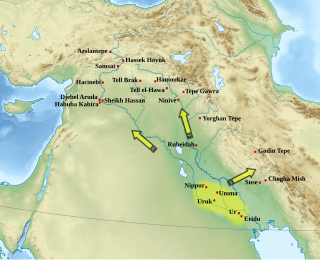
The Uruk period existed from the protohistoric Chalcolithic to Early Bronze Age period in the history of Mesopotamia, after the Ubaid period and before the Jemdet Nasr period. Named after the Sumerian city of Uruk, this period saw the emergence of urban life in Mesopotamia and the Sumerian civilization. The late Uruk period saw the gradual emergence of the cuneiform script and corresponds to the Early Bronze Age; it has also been described as the "Protoliterate period".

The Proto-Elamite period, also known as Susa III, is a chronological era in the ancient history of the area of Elam, dating from c. 3100 BC to 2700 BC. In archaeological terms this corresponds to the late Banesh period. Proto-Elamite sites are recognized as the oldest civilization in Iran. The Proto-Elamite script is an Early Bronze Age writing system briefly in use before the introduction of Elamite cuneiform.

The Proto-Elamite script is an early Bronze Age writing system briefly in use before the introduction of Elamite cuneiform.
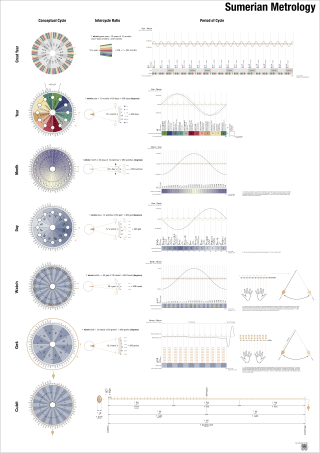
Ancient Mesopotamian units of measurement originated in the loosely organized city-states of Early Dynastic Sumer. Each city, kingdom and trade guild had its own standards until the formation of the Akkadian Empire when Sargon of Akkad issued a common standard. This standard was improved by Naram-Sin, but fell into disuse after the Akkadian Empire dissolved. The standard of Naram-Sin was readopted in the Ur III period by the Nanše Hymn which reduced a plethora of multiple standards to a few agreed upon common groupings. Successors to Sumerian civilization including the Babylonians, Assyrians, and Persians continued to use these groupings. Akkado-Sumerian metrology has been reconstructed by applying statistical methods to compare Sumerian architecture, architectural plans, and issued official standards such as Statue B of Gudea and the bronze cubit of Nippur.
Jemdet Nasr is a tell or settlement mound in Babil Governorate (Iraq) that is best known as the eponymous type site for the Jemdet Nasr period, and was one of the oldest Sumerian cities. It is adjacent to the much larger site of Tell Barguthiat. The site was first excavated in 1926 by Stephen Langdon, who found Proto-Cuneiform clay tablets in a large mudbrick building thought to be the ancient administrative centre of the site. A second season took place in 1928, but this season was very poorly recorded. Subsequent excavations in the 1980s under British archaeologist Roger Matthews were, among other things, undertaken to relocate the building excavated by Langdon. These excavations have shown that the site was also occupied during the Ubaid, Uruk and Early Dynastic I periods. Based on texts found there mentioning an ensi of NI.RU that is thought to be its ancient name. During ancient times the city was on a canal linking it to other major Sumerian centers.
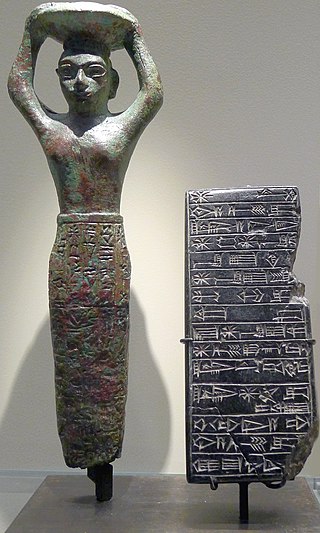
Amar-Sin, initially misread as Bur-Sin middle chronology, was the third ruler of the Ur III Dynasty. He succeeded his father Shulgi. His name translates to 'bull calf of the moon-god'. The name Amar-Sin was not recorded before his ascension and is a "throne name". His original name, and whether he was actually the son of Shugi, is unknown. It has been proposed that Amar-Sin, Shu-Sin, and Ibbi-Sin were all brothers and sons of Shulgi. Alternatively it has been suggested that Amar-Sin was a nephew of Shulgi, explaining his difficulties at the beginning and ending of his reign.

Linear Elamite was a writing system used in Elam during the Bronze Age between c. 2300 and 1850 BCE, and known mainly from a few extant monumental inscriptions. It was used contemporaneously with Elamite cuneiform and records the Elamite language. The French archaeologist François Desset and his colleagues have argued that it is the oldest known purely phonographic writing system, although others, such as the linguist Michael Mäder, have argued that it is partly logographic.

Denise Schmandt-Besserat is a French-American archaeologist and retired professor of art and archaeology of the ancient Near East. She spent much of her professional career as a professor at the University of Texas. She is best known for her work on the history and invention of writing. While her research is highly cited, it has been controversial among scholars. The controversies, as detailed below, concern the interpretation of early tokens, particularly the complex ones; however, the idea that writing emerged out of the counting, cataloging, management, and transactions of agricultural produce has been largely accepted.

The Awan dynasty was the first dynasty of Elam of which very little of anything is known today—appearing at the dawn of recorded history. The dynasty corresponds to the early part of the first Paleo-Elamite period ; additionally, succeeded by the Shimashki and Sukkalmah dynasties. The Elamites were likely major rivals of neighboring Sumer from remotest antiquity—they were said to have been defeated by Enmebaragesi of Kish c. 2750 BC—who is the earliest archaeologically attested king named on the Sumerian King List (SKL); moreover, by a later monarch, Eannatum of Lagash c. 2450 BC. Awan was a city-state or possibly a region of Elam whose precise location is not certain; but, it has been variously conjectured to have been within the: Ilam and/or Fars provinces of what is today known as the Islamic Republic of Iran, to the north of Susa, close to Dezful, or Godin Tepe.

Entemena, also called Enmetena, was a son of Enannatum I who re-established Lagash as a power in Sumer. He defeated Il in a territorial conflict through an alliance with Lugal-kinishe-dudu of Uruk, successor to Enshakushanna, who is in the king list. The tutelary deity Shul-utula was his personal deity. His reign lasted at least 19 years.
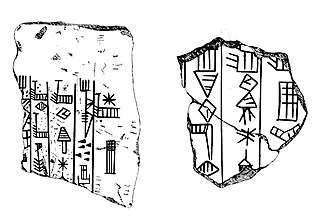
Enshakushanna, or Enshagsagana, En-shag-kush-ana, Enukduanna, En-Shakansha-Ana, En-šakušuana was a king of Uruk around the mid-3rd millennium BC who is named on the Sumerian King List, which states his reign to have been 60 years. He conquered Hamazi, Akkad, Kish, and Nippur, claiming hegemony over all of Sumer.

Marhaši was an important ancient Near East polity situated in the region near Elam. It is generally assumed, though not certain, that the Paraḫšum/Baraḫšum of the Akkadian Empire period referred to Marhaši. This equivalence has been challenged. It is known from 3rd millennium BC and early 2nd millennium BC Mesopotamian sources. Its precise location has not been identified but the current thinking places it on the eastern side of the Iranian plateau.
Tell Uqair is a tell or settlement mound northeast of ancient Babylon, about 25 kilometers north-northeast of the ancient city of Kish, just north of Kutha, and about 50 miles (80 km) south of Baghdad in modern Babil Governorate, Iraq. It was occupied in the Ubaid period and the Uruk period. It has been proposed as the site of the 3rd millennium BC city of Urum.
The Cuneiform Digital Library Initiative (CDLI) is an international digital library project aimed at putting text and images of an estimated 500,000 recovered cuneiform tablets created from between roughly 3350 BC and the end of the pre-Christian era online. Directors of the project are Robert Keith Englund from University of California, Los Angeles and Jürgen Renn of the Max Planck Institute for the History of Science. Co-principal investigators are Jacob Dahl at Oxford University, Bertrand Lafront at the Centre national de la recherche scientifique, Nanterre and Émilie Pagé-Perron, University of Toronto. Preceding leadership comprised co-director Peter Damerow (1939–2011) from the Max Planck Institute for the History of Science and Pennsylvania Sumerian Dictionary leader Stephen J. Tinney who was co-principal investigator. In 2004, Englund received the Richard W. Lyman Award from the National Humanities Center for his work on the initiative.
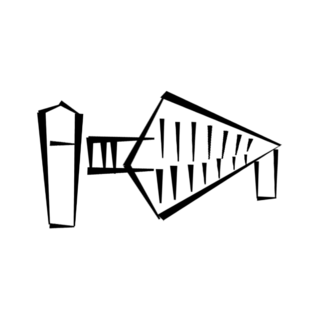
Kushim is supposedly the earliest known recorded name of a person in writing. The name "Kushim" is found on several Uruk period clay tablets used to record transactions of barley. It is uncertain if the name refers to an individual, a generic title of an officeholder, or an institution.
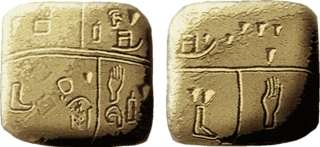
The proto-cuneiform script was a system of proto-writing that emerged in Mesopotamia, eventually developing into the early cuneiform script used in the region's Early Dynastic I period. It arose from the token-based system that had already been in use across the region in preceding millennia. While it is known definitively that later cuneiform was used to write the Sumerian language, it is still uncertain what the underlying language of proto-cuneiform texts was.
References
- ↑ "Robert K. Englund | UCLA Cotsen Institute of Archaeology". ioa.ucla.edu. Retrieved December 13, 2024.
- ↑ "Robert K. Englund". Cuneiform Digital Library Initiative .
- ↑ Englund, Robert K. (1990). Organisation und Verwaltung der Ur III-Fischerei. D. Reimer. ISBN 9783496003892.
- ↑ Carter, Anna Rose (June 10, 2018). "Retiring professors leave behind legacy of passion for Near Eastern archaeology". Daily Bruin .
- ↑ "| TeamQuantum Photonics Laboratory | RLE at MIT". qp.mit.edu. Retrieved November 30, 2023.
- ↑ "Tributes: Bob Englund". June 5, 2020.
- ↑ "Archaische Texte aus Uruk (Irak)". October 17, 2007.
- ↑ "Excavations at Tepe Yahya, Iran, 1967-1975, Volume II: The Proto-Elamite Texts from Tepe Yahya — Peter Damerow, Robert K. Englund".
- ↑ Englund, R. K. (2009). "The Smell of the Cage 1". S2CID 6714012.
{{cite journal}}: Cite journal requires|journal=(help) - ↑ "Publications". Cuneiform Digital Library Initiative .
- ↑ "Web library assembling ancient written documents". usatoday30.usatoday.com. May 17, 2002. Archived from the original on August 28, 2020.
- ↑ Cuneiform Digital Library Initiative
- ↑ Estrin, Daniel (February 13, 2015). "Archäologie: Streit über Schrifttafeln in Jerusalemer Ausstellung". Die Welt.
- ↑ "Machine assisted translation of cuneiform texts". Cuneiform Digital Library Initiative . April 3, 2017.
- ↑ Nissen, Hans J.; Damerow, Peter; Englund, Robert K. (2004). Informationsverarbeitung vor 5000 Jahren: Frühe Schrift und Techniken der Wirtschaftsverwaltung im alten Vorderen Orient ; Informationsspeicherung und -verarbeitung vor 5000 Jahren ; [Begleitpublikation zur Ausstellung "Frühe Schrift und Techniken der Wirtschaftsverwaltung im Alten Vorderen Orient" des Seminars für Vorderasiatische Altertumskunde der Freien Universität Berlin in Zusammenarbeit mit dem Forschungsbereich Entwicklung und Sozialisation des Max-Planck-Instituts für Bildungsforschung und dem Museum für Vor- und Frühgeschichte der Staatlichen Museen Preußischer Kulturbesitz, die im Museum für Vor- und Frühgeschichte, Berlin-Charlottenburg, vom 16. Mai bis 29. Juli 1990 stattfand]. Franzbecker. ISBN 3881204008.
- ↑ Nissen, Hans J.; Damerow, Peter; Englund, Robert K. (1993). Archaic Bookkeeping: Early Writing and Techniques of Economic Administration in the Ancient Near East. University of Chicago Press. ISBN 978-0-226-58659-5.
- ↑ "Cdli tablet". Cuneiform Digital Library Initiative .
- 1 2 "cdli tablet". apps.apple.com. June 12, 2015.
- ↑ ""cdli tablet" joins the Android family". Cuneiform Digital Library Initiative . October 18, 2017.
- ↑ Englund, Robert K. "ORGANISATION UND VERWALTUNG DER UR lli-FISCHEREI" (PDF).
- ↑ Englund, Robert K. "Texts from the Late Uruk Period" (PDF).
- ↑ Bauer, Josef; Englund, Robert K.; Krebernik, Manfred (1998). "Mesopotamien: Späturuk-Zeit und Frühdynastische Zeit". Orbis Biblicus et Orientalis. 160/1. doi:10.5167/uzh-151545.
- ↑ Damerow, Peter; Englund, Robert K. "The Proto-Elamite Texts from Tepe Yahya" (PDF).
- ↑ Nissen, Hans J.; Damerow, Peter; Englund, Robert K.; Englund, Robert K. (1993). Archaic Bookkeeping: Early Writing and Techniques of Economic Administration in the Ancient Near East. University of Chicago Press. ISBN 9780226586595.